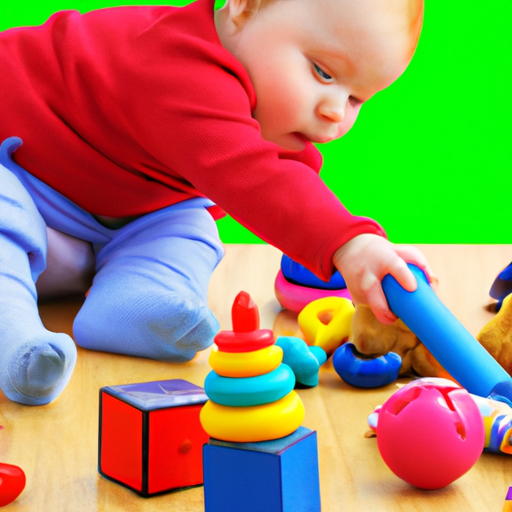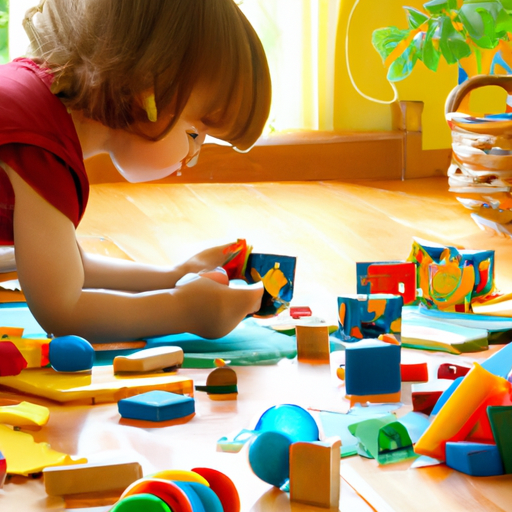In this article, we’ll explore the importance of interactive play in encouraging curiosity in babies. You’ll discover how engaging in playtime activities with your little one can stimulate their senses and help them develop cognitive and social skills. We’ll also share some fun and interactive play ideas that you can try with your baby. So, get ready to have some quality bonding time with your little one while boosting their curiosity and overall development.

What is Interactive Baby Play?
Interactive baby play refers to the engagement of babies in activities that stimulate their senses, promote exploration, and encourage their natural curiosity. It involves the use of interactive toys, objects, and experiences that allow babies to actively participate and engage with their environment. Interactive play is crucial for a baby’s development as it enhances their cognitive, physical, and social-emotional skills.
Benefits of Interactive Baby Play
There are numerous benefits associated with interactive baby play. By engaging in interactive play, babies have the opportunity to:
Enhance Cognitive Development
Interactive play provides babies with the chance to develop problem-solving skills. Through play, babies learn to use their imagination, think creatively, and find solutions to challenges they encounter. It also helps improve their memory and attention span, as they learn to focus on tasks and remember patterns.
Improve Physical Development
Interaction with different toys and objects during play helps babies develop their fine motor skills. Grasping, manipulating, and exploring various objects allow them to develop coordination and control over their movements. Additionally, interactive play promotes the development of hand-eye coordination, which is essential for tasks such as grasping objects or feeding themselves.
Foster Social and Emotional Development
Engaging in interactive play helps babies build emotional bonds with their caregivers. Through play, babies experience emotional connection and learn to trust their parents or caregivers. It also provides an opportunity to develop social skills, as babies learn to take turns, share, and interact with others during playtime. Moreover, interactive play allows babies to learn empathy and emotional regulation, as they understand and respond to the feelings and needs of others.

Types of Interactive Baby Play Objects and Toys
There are various types of interactive baby play objects and toys that parents can provide to encourage curiosity and engagement. The following are a few examples:
Sensory Toys
Sensory play is an essential component of interactive baby play. It involves engaging the baby’s senses and introducing them to different textures, colors, sounds, and smells. Examples of sensory toys include rattles, soft toys with different textures, musical toys, and toys that make different sounds when pressed or squeezed.
Cause and Effect Toys
Cause and effect toys are particularly fascinating for babies as they allow them to understand the relationship between their actions and the consequences. Toys such as pop-up toys, stacking toys, and toys with buttons that produce lights or sounds when pressed are examples of cause and effect toys. They help babies learn about cause and effect relationships and develop an understanding of how their actions can lead to specific outcomes.
Interactive Books and Music
Introducing interactive books and music can also be beneficial for encouraging curiosity in babies. Interactive books often have features such as flaps to lift, touch-and-feel textures, or sound buttons to press, which capture the baby’s attention and engage their senses. Similarly, playing music and singing songs during playtime can stimulate babies’ auditory senses and promote language development.
Encouraging Curiosity through Interactive Play
Interactive play provides an excellent opportunity for parents to encourage their baby’s curiosity. Here are a few ways interactive play enhances curiosity in babies:
Sensory Play
Sensory play encourages babies to explore and discover different textures, sounds, and smells. It sparks their curiosity as they encounter new sensory experiences. For example, filling a sensory bin with materials such as colored rice, water beads, or textured fabrics allows babies to touch, feel, and explore the various sensations. This stimulates their senses and encourages their curiosity to investigate and learn about their surroundings.
Cause and Effect Toys
Cause and effect toys are designed to captivate babies’ attention and inspire their curiosity. When babies interact with these toys, they begin to understand that their actions produce specific outcomes. For instance, when they press a button on a toy, lights may flash, or a sound may play. This cause and effect relationship intrigues babies and motivates them to explore further, wanting to understand how their actions lead to certain results.
Engaging in Pretend Play
During interactive play, parents can engage in pretend play scenarios with their babies. Through imaginative play, babies are exposed to new concepts and can explore different roles and situations. This encourages curiosity as they become aware of new possibilities and learn about the world around them. Whether it’s playing with toy kitchen sets, pretending to be a doctor, or engaging in a tea party, pretend play allows babies to use their imagination and explore their creativity.

Creating an Interactive Play Environment
To create an optimal interactive play environment for your baby, consider the following:
Set up a Safe and Stimulating Play Area
Designate a specific area in your home where your baby can play safely. Ensure that the area is free from potential hazards and has soft flooring or mats to cushion any falls. Include age-appropriate toys, objects, and play materials that promote exploration and engagement. You can create different play zones within the area, such as a sensory play corner with various sensory toys and a pretend play area with props for imaginative play.
Choose Age-Appropriate Toys
When selecting toys for interactive play, it is essential to consider your baby’s age and developmental stage. Choose toys that are suitable for their current abilities and provide age-appropriate challenges. Toys that are too advanced may frustrate your baby, while those that are too simple may not hold their interest. Look for toys that are safe, durable, and encourage exploration and problem-solving.
Rotate Toys to Maintain Interest
To keep your baby engaged and curious, it is beneficial to rotate their toys regularly. When the same toys are constantly available, babies may lose interest over time. By periodically introducing new toys or reintroducing toys they haven’t played with in a while, you can provide fresh stimuli and stimulate their curiosity. Rotating toys also helps prevent overstimulation and allows babies to focus on specific toys or activities.
Engaging with Your Baby during Play
Engaging with your baby during play is crucial for their overall development. By actively participating and interacting with your baby, you can enhance their learning experience and strengthen your bond. Here are a few ways to engage with your baby during play:
Use Facial Expressions and Gestures
Babies are highly responsive to facial expressions and gestures. Smile, make eye contact, and use exaggerated facial expressions to show your interest and excitement during playtime. Use hand gestures, such as pointing or waving, to direct your baby’s attention towards toys or objects. Your positive and engaging demeanor will capture your baby’s attention and encourage their active participation.
Talk and Sing during Play
Talking and singing to your baby during playtime helps develop their language and communication skills. Describe the actions you and your baby are taking, label objects, and make sound effects. Sing songs, nursery rhymes, or make up your own tunes to stimulate their auditory senses. Engaging in conversation and providing verbal cues during play helps babies associate words with objects and actions, building their vocabulary and language comprehension.
Incorporate Parent-Child Interactions
Engaging in back-and-forth interactions with your baby is crucial for their social and emotional development. Respond to your baby’s actions, sounds, and gestures with positive reinforcement and encouragement. Play games that involve turn-taking, such as rolling a ball back and forth or participating in simple peek-a-boo activities. These interactions create a sense of connection between you and your baby, fostering their social skills and emotional well-being.

Benefits of Interactive Play for Cognitive Development
Engaging in interactive play offers numerous benefits for a baby’s cognitive development. Here are a few ways interactive play enhances cognitive skills:
Enhancing Problem-Solving Skills
Interactive play stimulates babies’ problem-solving abilities as they encounter challenges and find solutions during playtime. For example, stacking blocks, fitting shapes into corresponding holes, or completing puzzles can help develop their spatial awareness, logical thinking, and problem-solving skills.
Improving Memory and Attention Span
Through interactive play, babies are exposed to repetition and patterns, which aid in memory development. Playing games that involve memorizing sequences, such as Simon Says or memory match games, can enhance their memory skills. Furthermore, interactive play helps improve their attention span as they learn to focus on specific tasks and activities.
Developing Language and Communication Skills
Interactive play provides opportunities for babies to develop their language and communication skills. Conversations with parents, labeling objects, and singing songs during playtime expose babies to meaningful language input. This helps them associate words with objects, actions, and concepts, strengthening their vocabulary and understanding of language.
Benefits of Interactive Play for Physical Development
Engaging in interactive play promotes physical development in babies. Here are a few ways interactive play benefits their physical growth:
Developing Fine Motor Skills
Interactive play involving toys that encourage grasping, manipulating, and precise hand movements helps babies develop their fine motor skills. Picking up small objects, stacking blocks, or turning the pages of a book are activities that enhance their hand and finger coordination, dexterity, and control.
Improving Hand-Eye Coordination
Interactive play involves activities that require babies to coordinate their hand movements with their visual perception. Throwing and catching a ball, fitting shapes into corresponding holes, or building with blocks are examples of activities that improve hand-eye coordination. The ability to synchronize their movements with what they see helps babies develop their motor skills and spatial awareness.
Encouraging Gross Motor Skills
Interactive play also provides opportunities for babies to engage in activities that enhance their gross motor skills. Crawling through tunnels, playing with large balls, or rolling on a padded mat allow babies to practice and improve their balance, coordination, and overall physical strength.

Benefits of Interactive Play for Social and Emotional Development
Interactive play plays a significant role in the social and emotional development of babies. Here’s how it benefits their growth:
Building Emotional Bonds with Caregivers
Engaging in interactive play allows babies to develop a secure emotional bond with their parents or caregivers. The positive interactions, responsive feedback, and shared experiences during playtime create a sense of trust, love, and emotional connection between the baby and their caregiver. This emotional bond forms the foundation for healthy social and emotional development.
Developing Social Skills through Play
Interactive play provides a platform for babies to learn and practice essential social skills. By interacting with their parents or other children, babies learn to take turns, share objects, and cooperate. They begin to understand the concept of reciprocity and start to imitate social behaviors they observe during play.
Learning Empathy and Emotional Regulation
During interactive play, babies have opportunities to learn empathy and emotional regulation. They observe their parents or caregivers responding to their needs, emotions, and cues. Through these interactions, babies begin to understand and recognize the feelings of others, developing empathy and compassion. Furthermore, interactive play allows babies to explore and express their emotions in a safe and supportive environment, learning how to regulate their emotions effectively.
Choosing Interactive Play Activities
When selecting interactive play activities for your baby, consider activities that encourage exploration, creativity, and engagement. Here are a few examples:
Exploring Sensory Bins and Materials
Sensory bins filled with materials such as rice, water beads, or sand provide babies with opportunities to explore different textures, colors, and sensations. Add scoops, measuring cups, or small toys to enhance the sensory experience. Monitor your baby closely during sensory play to ensure their safety.
Engaging in Pretend Play
Pretend play allows babies to use their imagination, role-play, and explore different scenarios. Provide props and toys that encourage imaginative play, such as toy kitchen sets, doctor kits, or dollhouses. Engage with your baby by participating in pretend play scenarios together, enhancing their creativity and social skills.
Introducing Interactive Books and Music
Interactive books with features like flaps, touch-and-feel elements, or sound buttons capture babies’ attention and stimulate their curiosity. Incorporate interactive books into your baby’s playtime routine, and encourage them to turn the pages, explore the textures, or press the buttons. Similarly, playing music or singing songs together can be a fun and engaging activity that promotes language development and auditory stimulation.
Safety Considerations for Interactive Baby Play
Ensuring the safety of your baby during interactive play is of utmost importance. Here are some safety considerations to keep in mind:
Checking for Age Appropriateness and Safety Standards
Before purchasing toys or play objects, carefully read the age recommendations and safety guidelines provided by the manufacturers. Ensure that the toys are suitable for your baby’s age and developmental stage. Avoid toys with small parts that could pose a choking hazard and ensure that all toys are free from toxic materials.
Regularly Inspecting Toys for Wear and Tear
Regularly inspect your baby’s toys for any signs of wear and tear, such as broken parts or loose pieces. Replace damaged toys immediately to prevent accidents. Check stuffed toys for loose buttons or eyes that could become a choking hazard. Additionally, make sure that batteries are securely enclosed in battery-powered toys to avoid any potential harm.
Supervising Play to Prevent Accidents
Always supervise your baby during interactive play. Babies are curious and may put toys or objects in their mouths, which can pose a choking hazard. Stay within arm’s reach of your baby and actively engage with them during playtime. Monitor their movements and ensure that the play area is free from potential hazards.
Conclusion
Interactive baby play is a valuable tool for encouraging curiosity in babies. Through a variety of interactive toys and activities, parents can create a stimulating environment that promotes cognitive, physical, and social-emotional development. By actively engaging with their babies during play and ensuring safety, parents can foster a sense of wonder and exploration in their little ones. Encourage your baby’s curiosity by providing age-appropriate toys, engaging in interactive play activities, and nurturing their development through positive interactions. Enjoy the precious moments of playtime with your baby as you witness their curiosity unfold.





